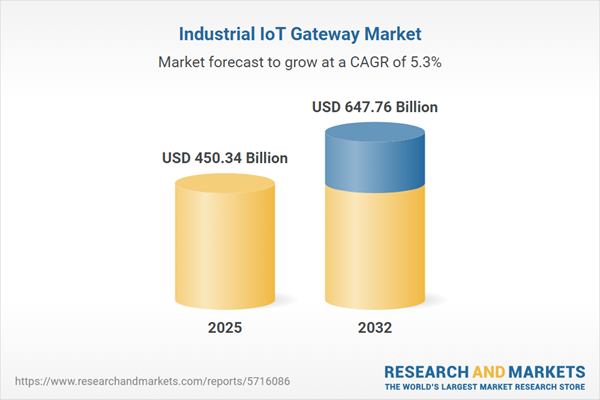Speak directly to the analyst to clarify any post sales queries you may have.
The industrial IoT gateway market is shaping the future of connected operations, allowing enterprises to transform legacy assets into intelligent, digitally linked systems. By bridging operational technology and IT, these gateways enable greater efficiency, security, and adaptability for organizations pursuing modernization and compliance.
Market Snapshot: Industrial IoT Gateway Market Size and Growth
The industrial IoT gateway market is on a strong growth trajectory, with total market size set to rise steadily between 2024 and 2032. This expansion is supported by increased capital allocation toward digital automation and a stronger drive for unifying operational technologies with information architecture. The demand for cloud-integrated solutions is also growing, as enterprises across various sectors migrate to unified frameworks to meet evolving compliance, risk, and efficiency requirements. Senior decision-makers are focusing on solutions that not only accelerate digital maturity but also adapt to shifting global and local business imperatives, ensuring organizational resilience.
Scope & Segmentation of the Industrial IoT Gateway Market
- Industry Verticals: Energy, utilities, healthcare, manufacturing, and transportation sectors are deploying tailored gateways to address complex compliance requirements and the distinctive needs of specialized processes.
- Deployment Types: Cloud-based deployments centralize analytics and decision-making, while on-premises solutions maintain higher levels of control for organizations with sensitive data or legacy systems.
- Connectivity: Gateways offer support for protocols including wired, Bluetooth, cellular, and Wi-Fi, ensuring adaptable integration with both legacy and new infrastructure investments.
- Applications: Predominant use cases include predictive maintenance, real-time asset tracking, fleet and grid management, and building automation, driving significant improvements in productivity and resource utilization.
- Regional Coverage: The Americas, Europe, Asia-Pacific, and the Middle East & Africa represent distinct markets, each with unique regulatory, economic, and technological maturity factors shaping deployment and adoption strategies.
- Companies Profiled: Leading providers such as Cisco Systems, Advantech, Moxa, Sierra Wireless, Digi International, HMS Networks, Dell Technologies, Huawei, Schneider Electric, and Rockwell Automation continuously refine their portfolios to address specific connectivity, compliance, and operational requirements within different regions.
Key Takeaways for Senior Decision-Makers
- Edge analytics embedded in industrial IoT gateways deliver actionable insights, elevating supervisory control and support for operational excellence across production and supply chain functions.
- Placing processing capabilities close to operational assets facilitates rapid responses and elasticity as data volumes and business demands increase, underpinning adaptability.
- Multi-protocol support enables incremental modernization, allowing organizations to phase in new technologies while maximizing current asset investments and operational continuity.
- Built-in authentication and encryption capabilities safeguard critical infrastructure, supporting robust responses to evolving cybersecurity and regulatory standards.
- Collaborative strategies between manufacturers and network service providers accelerate scalable IoT deployments and foster cross-sector innovation in diverse operational environments.
- Integrated industry-specific protocol support simplifies meeting evolving compliance criteria and strengthens alignment with shifting industry requirements.
Tariff Impact on Procurement and Manufacturing Strategies
Recent U.S. tariffs on key electronic and networking components are influencing how organizations manage procurement and production within the industrial IoT gateway segment. To sustain reliable supply chains, enterprises are deepening partnerships with regional suppliers and enhancing supply chain resilience. This situation is stimulating interest in modular gateway designs, which help organizations swiftly address potential component shortages, streamline system integration, and maintain deployment agility as supply chain or regulatory environments develop.
Methodology & Data Sources
This analysis draws on authoritative white papers, regulatory databases, and patent documentation. The methodology leverages expertise from automation engineers, technology experts, and cybersecurity professionals and uses SWOT, PESTEL, and Porter’s Five Forces frameworks to ensure findings mirror current industry realities.
Why This Report Matters
- Enables executives to bolster operational resilience and proactively address volatility and emerging risks within the industrial IoT gateway market.
- Equips decision-makers with actionable recommendations for data-driven modernization, enhanced security, and robust compliance as regulatory expectations evolve.
- Supplies the intelligence necessary to sustain competitive advantage and consistently create value in complex industrial settings undergoing digital transformation.
Conclusion
Industrial IoT gateways are pivotal for secure digital integration, supporting sustained operational transformation and compliance. This report offers strategic insights for leaders seeking to reinforce frameworks and drive efficiency amid industry change.
Additional Product Information:
- Purchase of this report includes 1 year online access with quarterly updates.
- This report can be updated on request. Please contact our Customer Experience team using the Ask a Question widget on our website.
Table of Contents
3. Executive Summary
4. Market Overview
7. Cumulative Impact of Artificial Intelligence 2025
List of Figures
Companies Mentioned
The companies profiled in this Industrial IoT Gateway market report include:- Cisco Systems, Inc.
- Advantech Co., Ltd.
- Moxa Inc.
- Sierra Wireless, Inc.
- Digi International Inc.
- HMS Networks AB
- Dell Technologies Inc.
- Huawei Technologies Co., Ltd.
- Schneider Electric SE
- Rockwell Automation, Inc.
Table Information
| Report Attribute | Details |
|---|---|
| No. of Pages | 186 |
| Published | November 2025 |
| Forecast Period | 2025 - 2032 |
| Estimated Market Value ( USD | $ 450.34 Billion |
| Forecasted Market Value ( USD | $ 647.76 Billion |
| Compound Annual Growth Rate | 5.3% |
| Regions Covered | Global |
| No. of Companies Mentioned | 11 |









